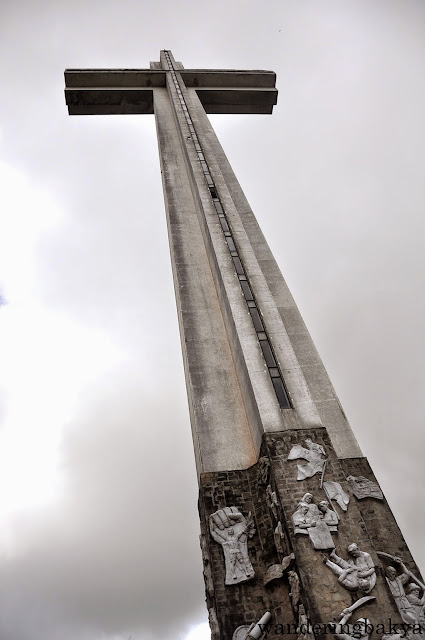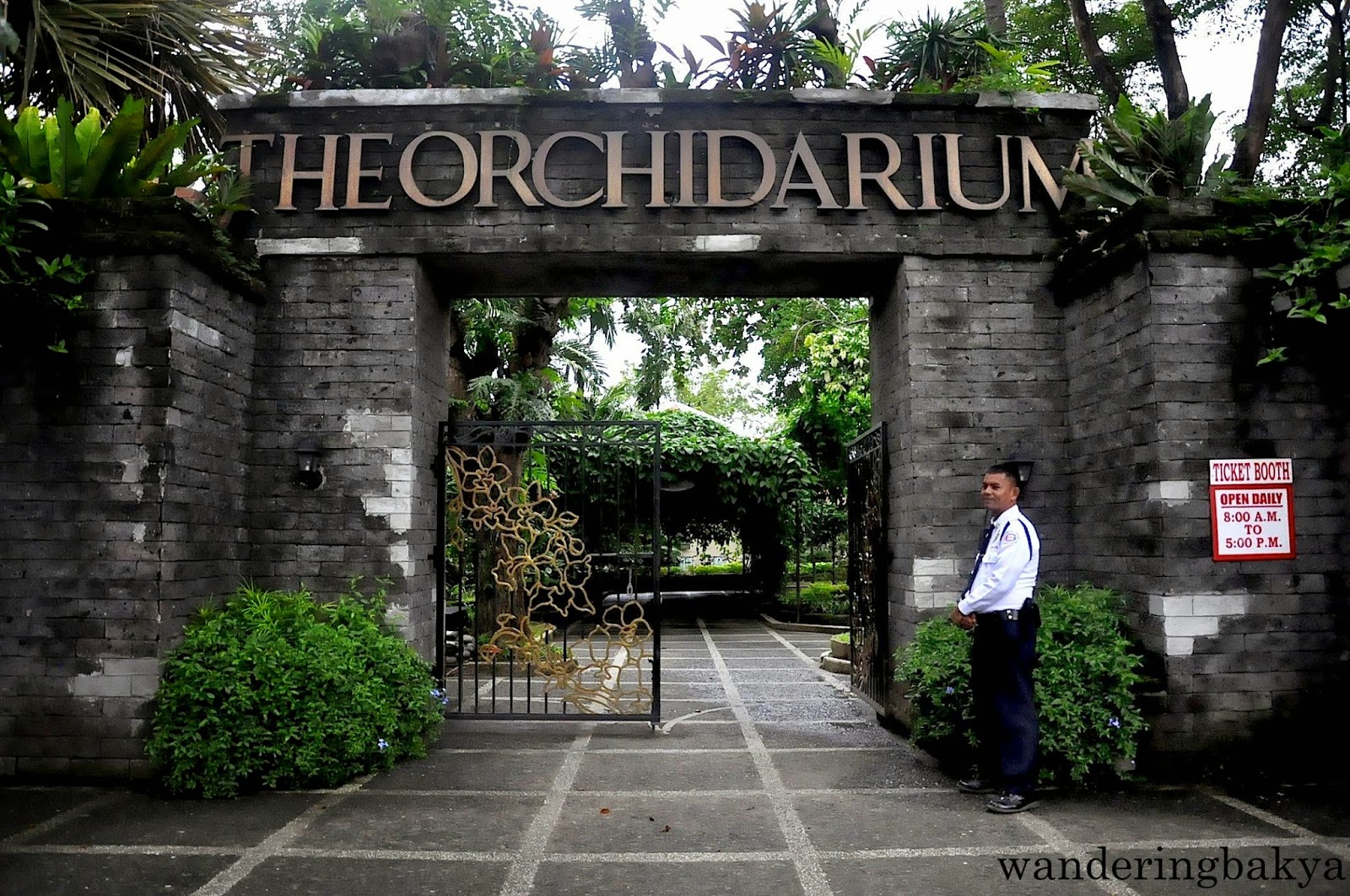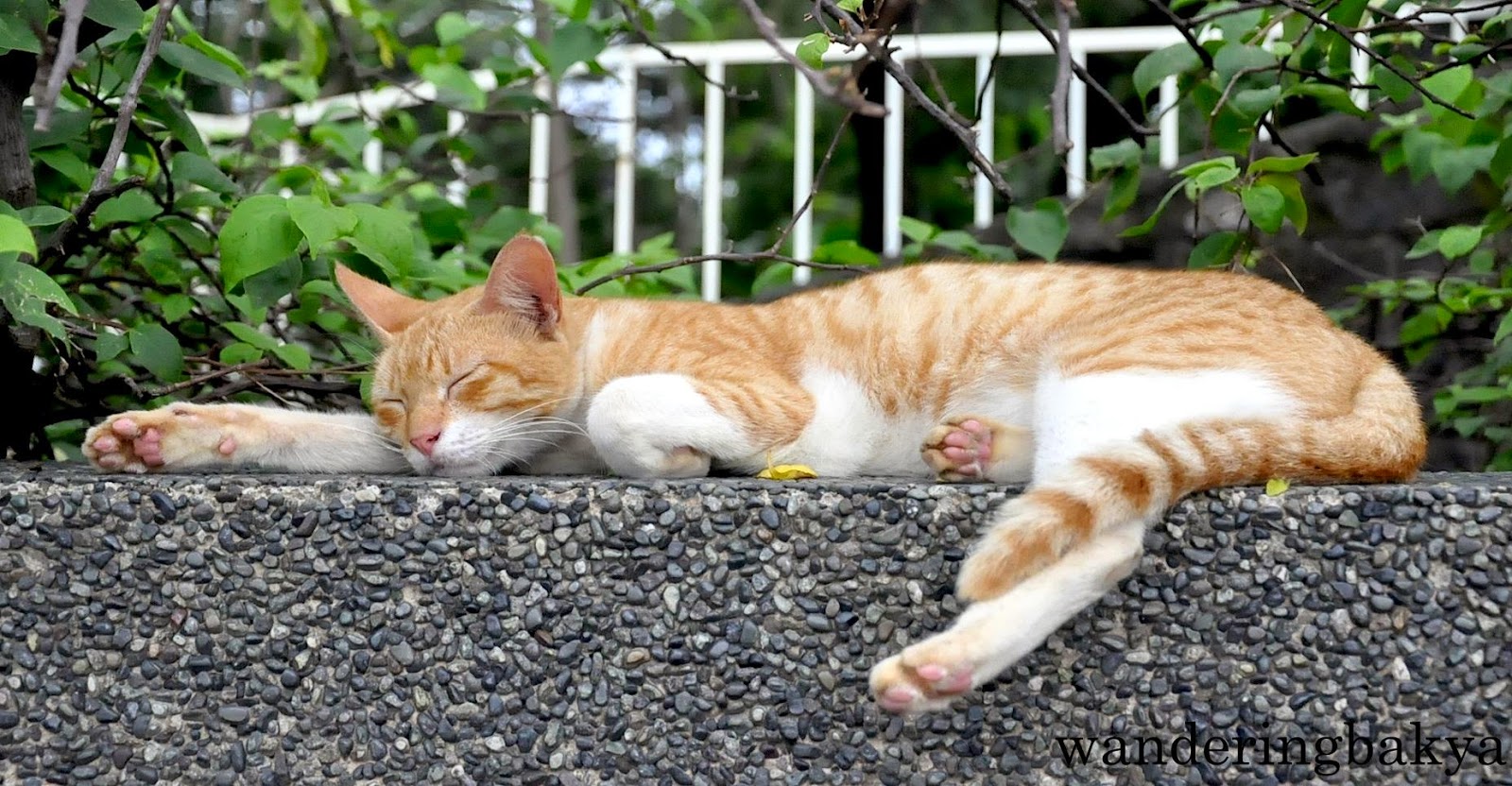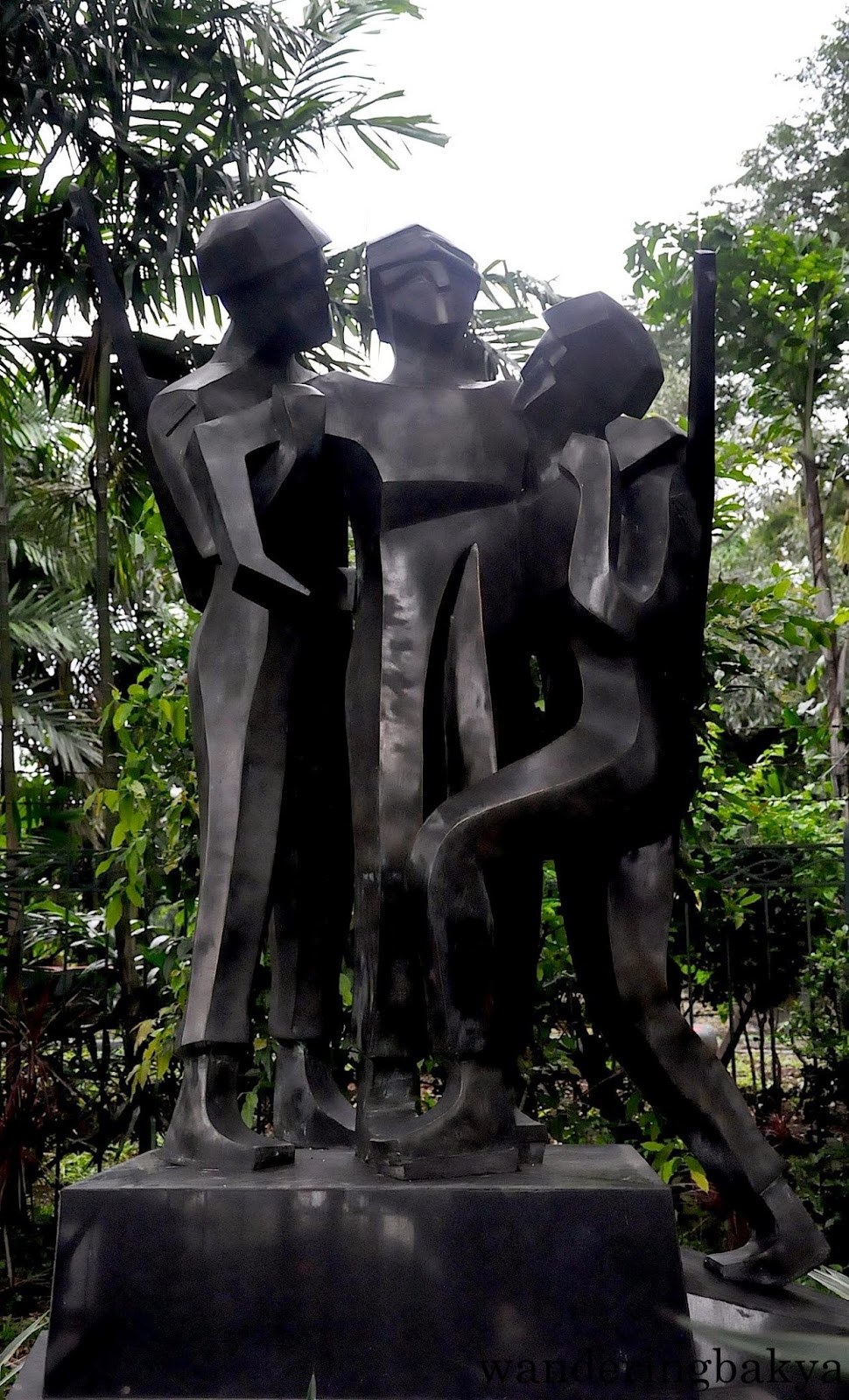 |
| Memorial Cross Photo by John |
Mount Samat National Shrine
On August 24, a day before Filipinos celebrate National Heroes Day, Virg, Jed, John and I drive to Pilar, Bataan to visit Mount Samat National Shrine or Dambana ng Kagitingan. Mount Samat is one of the historic mountains in the Philippines because it was chosen as the last stand of the Filipino and American soldiers who fought side by side against the Japanese forces during World War II. The Japanese troops mercilessly bombarded the area for six hours to force the members of USAFFE (United States Army Forces in the Far East) into submission. The capitulation of Mount Samat signaled the Fall of Bataan where 60,000 Filipino soldiers and 15,000 American soldiers were taken as prisoners of war and were forced to participate in the bloodiest phase of Philippine history, the Bataan Death March.
 |
| Marker found at the base of the Memorial Cross |
 |
| Howitzer was one of the weapons used to attack the Filipino and American soldiers on Mount Samat |
President Ferdinand Marcos laid the cornerstone of the shrine on April 14, 1966, but it was not completed until four years later. Marcos, a former lieutenant of the 21st Division of the Philippine Army and a hero of Bataan (according to a plaque on the inner wall of the Memorial Cross) raised the monument to perpetuate for all time the heroism of the Filipino race. After almost five decades, the Memorial Cross continues to stand proud on top of Mount Samat, without any hint of succumbing to the pressure caused by nature just like our grandparents who fought tooth and nail against the Japanese (my grandfather was a war veteran and he related to us some of the hardships he had experienced during the war).
 |
| Sign found at the foot of Mount Samat |
At the gate, we pay P20.00 (US $0.46) each and P20.00 (US $0.46) for a parking slot. We park near the gate and make our way to the steps of the Colonnade (Unbeknownst to us, there is a road leading straight to the top of Mount Samat. Take this road if one is too frail to climb the steps. We found out about this on our way out of the shrine). From this location, one can see the imposing Memorial Cross behind the Philippine flag. When one turns 180° the view of Bataan is on full display.
A bronze urn that symbolizes eternal flame is found on each side of the Colonnade. A series of glass stained mural stands behind the altar in the center of the Colonnade. The murals are dominated by three female figures. If one looks above, there are bronze chandeliers hanging from the ceiling. The left and right walls of the structure contain the account of the Battle of Bataan.
 |
| Jed on the steps leading to the Colonnade |
 |
| Urns on the left and right sides of the Colonnade |
 |
| Three glass stained murals and two bronze chandeliers found in the center of the Colonnade |
 |
| Bronze chandelier as seen from the altar of the Colonnade |
 |
| The narrative of the Battle of Bataan is inscribed on the left wall of the Colonnade |
The outer walls of the Colonnade are as important as the main part as they hold 19 relief structures and 18 insignias in alternating fashion. The relief structures by Napoleon Abueva show pivotal events of the Battle of Bataan.
 |
| Two of the 18 insignias of the USAFFE divisions that valiantly fought the Japanese troops. The insignia of 61st Division shows the island of Panay. Iloilo is one of the provinces in Panay. |
 |
| Reliefs of The Defense of the Abucay Line and Honorable Defeat and Final Victory |
Behind the Colonnade, there is a stone path that zigzags its way to the top of the mountain. It is an easy climb to the top, but the heat of the sun in the middle of the day (1130am) obliterates 90% of human energy. I advise anyone who wants to take this route to wear a cap or an oversized hat and have a bottle of water. On my way to the Memorial Cross, I rest for a few seconds to catch my breath, admire the scenery and take photos. From the stone path, I have a great view of the Colonnade in its entirety.
 |
| Colonnade as seen from the stone path |
After ascending the last set of stone path, the impressive figure of the Memorial Cross comes into view. The cross measures 92 meters from the base and its arms extend 15 meters on either side. The lower part of the base is filled with reliefs of key historical figures and events, which include the martyrdom of José Rizal, prominent figures of Lapu-Lapu, Antonio Luna, Gabriela Silang, Apolinario Mabini and Andres Bonifacio. The collection of reliefs found on 17 walls of the cross is called Nabiag na Bato, also by Abueva.
 |
| Memorial Cross from different angles |
 |
| Reliefs by Napoleon Abueva |
 |
| Gabriela Silang on one of the walls of the Memorial Cross |
According to the plaque beside the elevator, Mount Samat Memorial Cross was rehabilitated on April 28, 1998 courtesy of President Fidel Ramos. The elevator can carry ten people per trip to the arms of the cross. For P10.00 (US $0.23) and a few minutes of patiently waiting for one’s turn under a pine tree, one can visit the viewing gallery, 74-meter high in the sky. The elevator temporarily stops its operation between 12 and 1pm. We are on the penultimate group so the viewing gallery is not overflowing with people by the time we reach it.
The one-minute ride inside an old jam-packed elevator could be scary, but the view from the top is worth all the trouble especially for nature lovers. The gallery affords the visitor a 360° view of the Bataan landscape. Green is the predominant color due to the profusion of trees, and the air is cool and fresh! It is a great way to relax after a short hike to the summit.
 |
| This is the view behind me while I wait my turn to ride the elevator |
 |
| One of the trees behind the Memorial Cross |
 |
| The viewing gallery provides 360° view of scenery |
 |
| Taking a short break before we head out of the viewing gallery |
 |
| The viewing gallery is narrow, not unlike the elevator. |
Before we head back to the Colonnade, we witness a monkey swinging from tree branches to the delight of the visitors. It stops when people approach it and give it food. Muy mono.
 |
| Memorial Cross monkey with a scar on its left hand |
As soon as we reach the Colonnade, we decide to check the museum out. The museum contains World War II memorabilia. It is closed so we drive to the center of Balanga to have lunch.
Balanga
Balanga is a 15-minute drive away from Mount Samat. It has a beautiful square where the surrounding structures seem to complement each other.
 |
| Church of Balanga |
 |
| Balanga City Hall is perpendicular to the Church of Balanga |
 |
| The monument of José Rizal faces the Balanga City Hall |
 |
| Plaza Mayor de Balanga |
Death March Markers
Death March markers are found along the roads of Bataan, and they show the distance of the area from the point of origin of the Bataan Death March. They show two soldiers - one seems to have collapsed on the ground and the other one seems to be helping the former. Aside from the soldiers, they also contain the words “Death March” and the kilometer number.
Two of the numerous Death March markers we encounter on our trip are Kilometer 19 and Kilometer Zero. Kilometer 19 is located near the Dambana ng Kagitingan sign while Kilometer Zero is in the vicinity of the Japanese-Philippine Friendship Tower or Bagac Friendship Tower.
The Death March markers are easy to find because they are visible to the motorists and they appear every kilometer without fail.
 |
| Death March marker (19th km) |
 |
| Death March marker (Zero km) |
Bagac Friendship Tower
The Bagac Friendship Tower symbolizes the restoration of relationship between Philippines and Japan after the atrocious events that transpired during WWII. It is built only 200 meters away from Kilometer Zero or the location where Bataan Death March started.
 |
| The Bagac Friendship Tower |
Pawikan Conservation Center
The Pawikan Conservation Center is in Morong, Bataan, and a good 35 kilometers away from where we had lunch. We drive to the center with the hope (mostly mine) of holding a hatchling or burying my feet in fine powdery white sand or gazing at the varying hues of blue water.
The Pawikan Conservation Center is an unassuming place located near a what-looked-like-an-abandoned subdivision. Ex-poachers who have seen the error of their ways and have vowed to protect the pawikan or marine turtles that they used to prey on for quick cash run the center. Viewing fee is P20.00 (US $0.46) per person and parking is free. Generous souls can donate additional cash, as the center badly needs the financial infusion (in my opinion).
 |
| Pawikan Conservation Center |
Mr. Arnold Santos welcomes us and explains to us the things they do in the center. He describes the different species of pawikan, their behavior and life cycle.
 |
| Mr. Arnold Santos explains the behavior of pawikan |
 |
| Some of the endangered species of marine turtles |
According to Mr. Santos, the pawikan return to the shores of Bataan to lay eggs as if they have homing device that guides them back to the friendly place that took care of them. The members of the center get the eggs to save it from dogs that like to eat them and from crabs that destroy the soft shell. They bury the eggs 16 inches deep into the ground and wait eight to ten weeks for the hatchlings to crawl out.
 |
| Life cycle of a marine turtle |
Mr. Santos adds that marine turtles usually stop by their area in the months of November and December. They accept visitors who want to join them on their nightly trips to check the shore for pawikan. There are cottages and rooms for rent at the center. A room for four people costs P2400 (US $55.00) while a room for a group of 10 costs P3400 (US $77.91). I will recommend this for those who like adventure and intellectual stimulation but are not squeamish about a lot of things.
There is no hatchling for me to hold, so I settle for a short walk on the beach and taking photos of the not-so-white-but-fine (although not powdery) sand. The air is fresh, the sky is clear and the water looks clean. I gaze at the water long enough to see it merge with the azure sky. Everything is right in the world once again.
 |
| Beach adjacent to the Pawikan Conservation Center |
 |
| The parting message of the Pawikan Conservation Center to its visitors |
Bataan is a beautiful province, largely due to the superfluous presence of trees and its bucolic setting. The roads are lined with trees on both sides, an image that leads to the magical feeling of seeing the rays of God (once UV rays successfully penetrate through the canopy of trees and land on the road). The houses that dot the roads are mostly nipa huts; there are cattle and horses that roam around in the grasslands and chickens that cross the roads. I digress. Haha.
We proceed to Subic and feast our eyes on more towering trees and drool over chocolates of varying hues at the duty-free shops. I arrive home at 11pm, dog-tired but with a smile on my face.
















































































